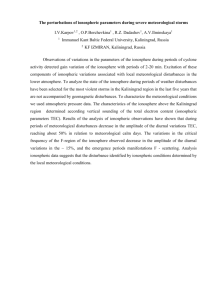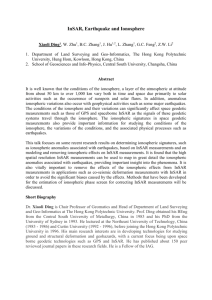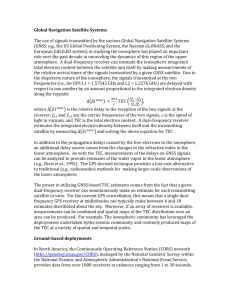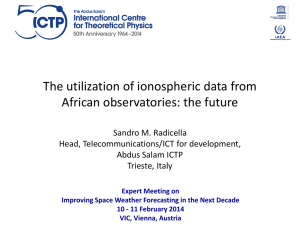TITLE IN BOLD BLOCK CAPITAL LETTERS
advertisement
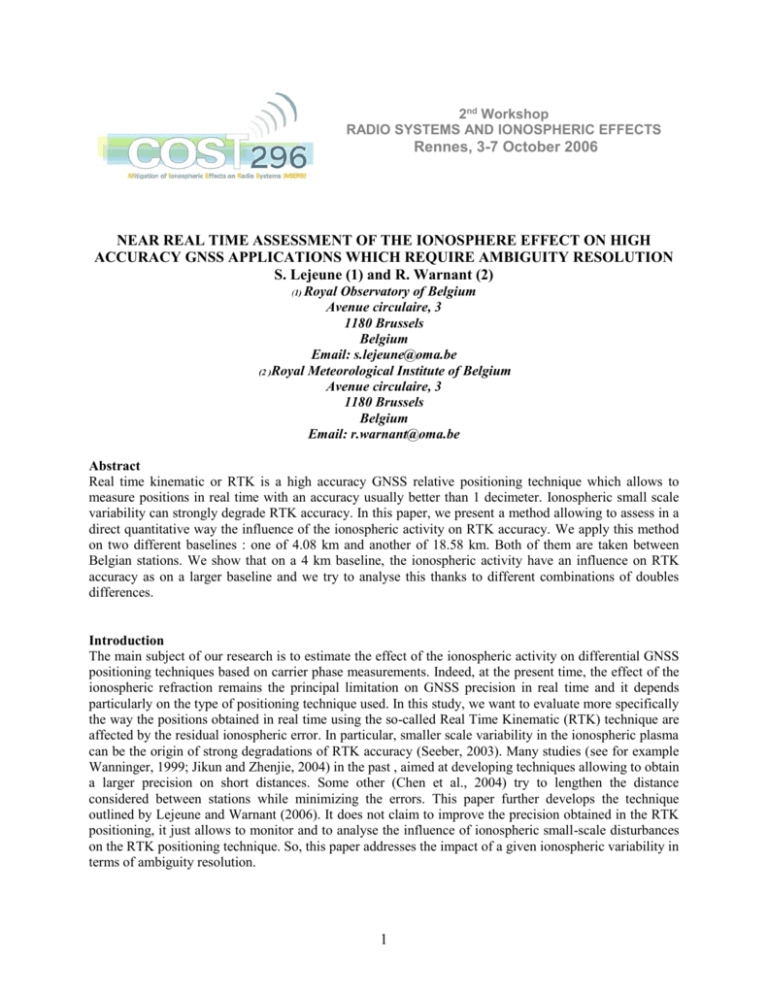
2nd Workshop RADIO SYSTEMS AND IONOSPHERIC EFFECTS Rennes, 3-7 October 2006 NEAR REAL TIME ASSESSMENT OF THE IONOSPHERE EFFECT ON HIGH ACCURACY GNSS APPLICATIONS WHICH REQUIRE AMBIGUITY RESOLUTION S. Lejeune (1) and R. Warnant (2) (1) Royal Observatory of Belgium Avenue circulaire, 3 1180 Brussels Belgium Email: s.lejeune@oma.be (2 )Royal Meteorological Institute of Belgium Avenue circulaire, 3 1180 Brussels Belgium Email: r.warnant@oma.be Abstract Real time kinematic or RTK is a high accuracy GNSS relative positioning technique which allows to measure positions in real time with an accuracy usually better than 1 decimeter. Ionospheric small scale variability can strongly degrade RTK accuracy. In this paper, we present a method allowing to assess in a direct quantitative way the influence of the ionospheric activity on RTK accuracy. We apply this method on two different baselines : one of 4.08 km and another of 18.58 km. Both of them are taken between Belgian stations. We show that on a 4 km baseline, the ionospheric activity have an influence on RTK accuracy as on a larger baseline and we try to analyse this thanks to different combinations of doubles differences. Introduction The main subject of our research is to estimate the effect of the ionospheric activity on differential GNSS positioning techniques based on carrier phase measurements. Indeed, at the present time, the effect of the ionospheric refraction remains the principal limitation on GNSS precision in real time and it depends particularly on the type of positioning technique used. In this study, we want to evaluate more specifically the way the positions obtained in real time using the so-called Real Time Kinematic (RTK) technique are affected by the residual ionospheric error. In particular, smaller scale variability in the ionospheric plasma can be the origin of strong degradations of RTK accuracy (Seeber, 2003). Many studies (see for example Wanninger, 1999; Jikun and Zhenjie, 2004) in the past , aimed at developing techniques allowing to obtain a larger precision on short distances. Some other (Chen et al., 2004) try to lengthen the distance considered between stations while minimizing the errors. This paper further develops the technique outlined by Lejeune and Warnant (2006). It does not claim to improve the precision obtained in the RTK positioning, it just allows to monitor and to analyse the influence of ionospheric small-scale disturbances on the RTK positioning technique. So, this paper addresses the impact of a given ionospheric variability in terms of ambiguity resolution. 1 Theoretical concepts The principle of RTK and the ionospheric influence RTK is a technique which allows to measure positions in real-time with a centimetre level accuracy. The RTK users combine their own phase measurements (we use the B notation throughout this paper) with the measurements made by a reference station (A notation used) of which the position is precisely known. The distance between the user and the reference station should not be larger than 10-20 km mainly depending on ionospheric activity. The RTK technique measures the baseline between the reference station (A) and the mobile user (B) by forming double differences of phase measurements. Thanks to this technique, we can measure positions in real time with an accuracy usually better than 1 decimeter. However, the RTK application is particularly sensitive to the effect of the ionosphere, in practice ionospheric variability on a small scale is the principal limit on the reliability and the precision of the RTK. The ionosphere is a dispersive medium, in which radio frequency signals are refracted by an amount dependent on the given signal frequency and the electron density, resulting in a range error : I Ai 40.3 TEC Ai f2 (1) where - (+) denotes the phase advance (group delay). The residual effect of the ionosphere on the RTK, I Ai , depends primarily on f the signal frequency (Hz) and on the ionospheric variability, or more exactly on the variability of the Total Electron Content (TEC) on distances of a few kilometers. Double differences The double difference is a linear combination of carrier phase (or code) measurements corresponding to a difference between two simple differences carried out at the same moment on two satellites i, j from the two receivers A, B. The simple differences are linear combinations of carrier phase (or code) measurements corresponding to a difference between the measurements from two receivers on the same satellite at the same moment. Double difference Ai ,,jB is obtained by making the difference of the two simple differences Ai ,B , Aj ,B taken simultaneously and relative to two different satellites i and j. Based on the simplified mathematical model of phase measurements (Leick, 2004), the equation of the double difference can be written as follow : ij AB f ij ij ij DAB TABi j I AB N AB c (2) with : ij DAB , the double difference of the geometric distance between receivers A and B and satellites i and j ; ij I AB , the residual ionospheric error remaining in the double differences ; TABi j , the residual tropospheric error remaining in the double differences ; ij N AB , the phase ambiguity (integer number) ; f , the considered carrier frequency (L1 or L2). 2 In the double differences, all the error sources which are common to the (one-way) carrier phase measurements performed by receivers A and B cancel, in particular, satellite and receiver clock errors. In addition, on short distances as used with RTK techniques, orbit residual errors can be neglected (Seeber, ij ij 2003). Residuals atmospheric effects I AB and TAB depend on the distance between the two station, A and B, and also on the atmospheric “activity”. Given the short distances considered, RTK data processing algorithms usually assume that residual atmospheric errors are negligible (Warnant et al., 2006-3). In this case, equation (2) can be rewritten : ij AB f ij ij DAB N AB c (3) with : ij DAB , contains the unknowns, the receiver B coordinates or more exactly the 3 components of the baseline vector. Let’s recall that the satellite i and j and station A (reference station) coordinates are known ; ij N AB , The integer to resolve for knowing the precise position of the user (B). At this step, we can note that the double differences must be checked for cycle slips : a cycle slip (due to a loss of lock) appearing in one of the two considered stations can cause an abrupt jump in the differential phase. According to the duration of the loss of signal, these cycle slips can be corrected. Nevertheless, an uncorrected cycle slip could be interpreted wrongly as a differential variation due to the ionosphere. As the cycles slips cause an abrupt phase variation in the doubles differences, it will be easy to insulate and to remove it using adapted thresholds. That was thus carried out. Ambiguity resolution Precise positioning with RTK requires the resolution of the ambiguity in real-time. In fact, one of the main problems which result from the analysis of carrier phase measurements is the ambiguity resolution in real time (or after a very short time). The first carrier phase measurement carried out by the receiver contains an unknown integer number which is called integer ambiguity. Mostly, before the treatments, this unknown number presents a non-integer value and we name it : float ambiguity. RTK uses sophisticated data processing algorithms which allow to resolve phase ambiguities in a few minutes as long as residual atmospheric errors remain negligible with respect to GNSS carrier wavelength (about 20 cm). Equation (3) can thus be rewritten as : ij AB f ij ij DAB N AB c (4) This assumption is valid in most of the cases but disturbed ionospheric and Space Weather conditions can be the origin of smaller-scale variability in TEC which can itself strongly degrade or even prevent ambiguity resolution. Methodology We developed a software allowing the phase ambiguity resolution similar to the software used on the field by RTK users (Lejeune and Warnant, 2006). Initially, float ambiguities are solved by least squares. In general, the ambiguity estimated by least squares will not be exactly an integer number due to remaining residual errors like the residual error due to the ionosphere. However, the best precision level is reached when ambiguities are fixed at their integer value. There are many techniques for ambiguity resolution (Seeber, 2003). In our case, once float ambiguities and the matrix of covariance of the adjustment are obtained the Lambda method (Joosten, 2000) is used for the calculation of integer ambiguities. 3 The Lambda method was created to determine the integer values of ambiguities. The necessary entries to the implementation of this method are the matrix of variance-covariance as well as the estimated float ambiguities vector. As output, this method provides estimated integer ambiguities (the most probable for the least squares) which once fixed, will allow to calculate the unknown factors dx, dy, dz corresponding to the difference between the calculated position and the known position. In addition to this ambiguity resolution software, we created a second software able to measure the differential phase variation (between two GNSS stations) due to the ionosphere. By comparing the results of both software, we can evaluate the ionospheric effect on the ambiguity resolution. In fact, the differential carrier phase variation due to the ionosphere affects the ambiguity resolution when this variation is not negligible compared to the wavelength of GNSS signals. Results To analyse the degradation of RTK positioning due to the ionosphere, we used measurements collected in two permanent Belgian GNSS stations of which position are precisely known (at a few millimetre level). As already explained, RTK can be used on distances up to 20 km and the influence of atmospheric (ionospheric and tropospheric) residual errors increases with the distance between the reference station and the mobile user. In a first step, this method has been tested on short distances (+/- 4 km) where the ionosphere is the only error source which could affect the ambiguity resolution. In a second step, we considered a larger baseline of 18.58 km. Baseline of 4.08 km 3 Residual error (meters) 2 1 0 -1 -2 0 2 4 6 8 Time (hours) Figure 1 : Difference between station B true position (x component) and computed position without ambiguity resolution (black line) and with ambiguity resolution (green line), baseline Brussels - Saint Gilles, 5th January 2004 between about 0H00 and 8H00 UT Figure 1 shows the output of our RTK simulation software. This software outputs the three components (XB, YB, ZB) of the user position. To fix the ideas, we choose to show the X component but similar results are obtained for the Y or Z components. We can see, on figure 1, some results for a short baseline between Brussels and Saint Gilles, two Belgian stations. The day analysed is the 5 January 2004. The black line of the graph gives the value in meters for the unknown residual position dx before the ambiguity resolution in function of the time. In fact when we spoke about the unknown residuals positions, we want to spoke 4 about the residuals in function of the real known position of the station. After ambiguity resolution with the Lambda method, we obtain new results which are presented by the green curve. We can note a real improvement in the results, indeed all the residual errors are equal to zero. This illustrates “usual” conditions. When we process measurements taken at the end of the same day (black line on figure 2), we obtained a more agited curve. Indeed, the standard deviation of the values is equal to 0.21m in comparison with before (black line on figure 1) where the standard deviation was equal to 0.13m. If we look now at the green curve of figure 2, when we inject integer ambiguity, we detected a non-negligible degradation of about two meters as maximum value and with a doubled value of the standard deviation equal to 0.54m . The main question here is : what is the cause of this ambiguity process degradation? 3 Residual error (meters) 2 1 0 -1 -2 18 19 20 21 22 23 24 Time (hours) Figure 2 : Difference between station B true position (x component) and computed position without ambiguity resolution (black line) and with ambiguity resolution (green line), baseline Brussels & Saint Gilles, 5th January 2004 between about 19H00 and 24H00 UT 0.4 DTEC (TECU/min) 0.2 0 -0.2 -0.4 18 19 20 21 22 23 24 Time (hours) Figure 3 : TEC noise-like variability observed at Brussels on 5th January 2004 along the track of satellite 20 5 Figure 3 shows that strong variability in TEC is observed between 19H00 and 21H00 on the track of satellite 20. This figure is obtained using a technique allowing to reconstruct TEC developed by Warnant et al.(2000). It allows to detect ionospheric smaller-scale disturbances along the track of all the observed satellites, using the so-called geometric free combination of GNSS dual frequency measurements. Thanks to this method, we can analyse the various phenomena being able to cause such gradients in space : especially Travelling Ionospheric Disturbances or TIDs, the scintillations or “noise-like” variability in TEC (Warnant et al., 2006-3). Scintillations are fast variations in amplitude and phase of electromagnetic signals crossing ionospheric regions where the free electrons concentration is strongly inhomogeneous. Scintillations are observed in the polar and in the equatorial ionosphere. In mid-latitude stations like Brussels (51 deg. Latitude), “noise-like” variability in TEC can also be observed as we can note on the figure 3. Baseline of 18.58 km 8 Residual error (meters) 4 0 -4 -8 8 10 12 14 Time (hours) Figure 4 : Difference between station B true position (x component) and computed position without ambiguity resolution (black line) and with ambiguity resolution (green line), baseline Bert & Mechelen, 24th December 2004 between about 8H00 and 14H00 UT On figure 4, we consider a larger baseline between two other Belgian stations. In this case, the introduction of integer ambiguities (green curve) presents residuals values little different from values obtained on base of the floating ambiguities (black curve). The numerical values of the standard deviation confirm it because we obtain 1.95m and 1.99m respectively for residues without and with resolution of the integer ambiguities. The reason could be the larger baseline but if we look at the TEC variation (figure 5), we can note the presence of a TID detected at Brussels on the same day, on the track of satellite 17. TIDs are waves in the electronic density. Nowadays, it is generally accepted that TIDs find their origin in a coupling between the neutral atmosphere and the ionosphere. They have wavelengths ranging from a few km to more then thousand km. The smaller-scale TIDs can be the origin of TEC variability of the order of 1 TECU/min even on distances of a few km (Warnant et al., 2006-1; Warnant et al., 2006-2). 6 0.8 DTEC (TECU/min) 0.4 0 -0.4 10 11 12 13 Time (hours) Figure 5 : TEC variability (TECU/min) due to a TID detected at Brussels on 24th December 2004 along the track of satellite 17. At this step of the study, we can ask : is the larger baseline responsible for the ambiguity resolution process non-improvement or the ionospheric variability? To answer to this question and thus to analyse precisely why there is a non-improvement in the accuracy of the computed positions and to specify the role of the ionospheric variability : we will look in details the behaviour of the double differences. We want to observe not only the double differences on L1 and on L2 but also the different other combinations which will contribute in a complementary way to the analysis. First (equation 5), the geometric free combination makes it possible to try to model the ionosphere because the effects of the orbit, receivers and satellites clocks as well as the tropospheric effects are eliminated. Next (equation 6), the ionospheric free combination has the advantage of eliminating the effect of the ionospheric refraction. Finally, the principle of the wide-laning, in the equation 7, is to combine measurements to increase the wavelength. The ambiguity resolution will be less affected by errors. ip ,GF ip ,L1 f L1 i p ,L 2 f L2 f L21 f f ip ,L1 2L1 L 22 ip ,L 2 2 2 f L1 f L 2 f L1 f L 2 1 ip ,WL ( f L1 ip ,L1 f L 2 ip ,L 2 ) f L1 f L 2 ip , IF (5) (6) (7) If we look at double differences of all theses combinations (figure 6) on the 24 December in 2004 for the baseline of 18.58 km, for one couple of satellite (satellite 17 and satellite 1), we can observe a variation of ij about 1 cycle in the L1 double difference. In fact, this figure gives us the value of the ambiguities, N AB , ij ij obtained thanks to the equation 4 where we considered that I AB and TAB were negligible. Secondly, for the L2 double difference, the signature of the curve seems to be like those of the L1 with a larger amplitude (about 2 cycles). We note that in this case, it is not possible to fix the integer value of the ambiguities. If we look after at the geometric free combination (L4), with which we can monitor the ionosphere, we observe that the curve is disturbed, the numerical values oscillates between to integer 7 ij values of N AB , 23 and 24 cycles. We can thus say that the ionospheric variability has here a real impact. The ionospheric free combination (L3) with which we eliminate the effect of the ionospheric refraction, confirms the role of the ionosphere. In fact, the curve is completely flat, in practice it means that if we suppress the ionospheric effect, it will be easier to fix the ambiguities to their integer values. Finally, the last combination, the wide-laning combination not oscillating around an integer, confirms the impact on the double difference due to the ionospheric variability on this short distance of about 18 km. 12 N given by equation 4 (cycles) 8 ddL1 ddL2 ddL4 ddL3 wide-laning 21 11 7 -11 24 -12 23 -13 22 -14 20 10 6 25 19 9 11.2 11.6 12 12.4 Time (hours) Figure 6 : Doubles differences (in cycles) between satellite 17 and satellite 1, on the baseline between Bert and Mechelen for the 24th December 2004. Conclusions In this paper, we present a method which allows to obtain a quantitative assessment of the influence of ionospheric small-scale variability on the so called Real time kinematic positioning technique. The study demonstrates thanks to the analyze of the double differences, that even on short distances (about 4 km), the presence of a strong ionospheric disturbance (i.e. a strong Traveling Ionospheric Disturbance) can be the origin of residual differential ionospheric effects which can affect the ambiguity resolution and degrade the accuracy of real time positions at a few meter level. For a larger baseline (Bert-Mechelen), we note a non-improvement between the computed and the true station position what provides a direct quantitative assessment of the error. Moreover, thanks to the analyze of the double differences, we have the confirmation of the ionospheric role in this unknown residuals non-improvement. On the basis of this analysis and on the Belgian dense network : we project to assess the reliability of some already existing ionospheric index (tool allowing GNSS users to detect periods where the ionospheric variability can degrade their results) (Wanninger, 1999). References Chen, H.Y., C. Rizos, S. Han, An instantaneous ambiguity resolution procedure suitable for medium scale GPS reference station network, Surv. Rev., 37(291), 396-410, 2004. Jikun, O., W. Zhenjie, An improved regularization method to resolve integer ambiguity in rapid positioning using single-frequency GPS receivers. Chin Sci. Bull, 49(2), 196-200, 2004. Joosten, P., C. Tiberius, Fixing the Ambiguities : Are You Sure They’re Right ? GPS World, 11 (5), 4651, 2000. 8 Leick, A., GPS Satellite Surveying 3rd Edition. John Wiley & Sons, New York, 435 p, 2004. Lejeune, S., R. Warnant, A novel method for the quantitative assessment of the ionosphere effect on high accuracy GNSS applications which require ambiguity resolution, Journal of Atmospheric and SolarTerrestrial Physics, in review, 2006. Seeber, G., Satellite Geodesy Second Edition. de Gruyter, New-York, 589 p, 2003. Wanninger, L., The performance of Virtual Reference Stations in active geodetic GPS-networks under Solar Maximum conditions, Proc. ION GPS 99, Nashville TN, 1419-1427, 1999. Warnant, R., E. Pottiaux, The increase of the ionospheric activity as measured by GPS. Earth, Planets and Space, 52(11), 1055-1060, 2000. Warnant, R., I. Kutiev, P. Marinov, M. Bavier, S. Lejeune, Ionospheric and geomagnetic conditions during periods of degraded GPS position accuracy : 1. Monitoring variability in TEC which degrades the accuracy of Real Time Kinematic GPS application, Adv. Space Res, in press, 2006-1. Warnant, R., I. Kutiev, P. Marinov, M. Bavier, S. Lejeune, Ionospheric and geomagnetic conditions during periods of degraded GPS position accuracy : 2. RTK events during disturbed and quiet geomagnetic conditions, Adv. Space Res, in press, 2006-2. Warnant, R., S. Lejeune, M. Bavier, Space Weather influence on satellite-based navigation and precise positioning, Space Weather – Research towards Applications in Europe, Astrophysics and Space Science Library series, vol. 344, Ed. J.Lilensten, Springer, 2006-3. 9
